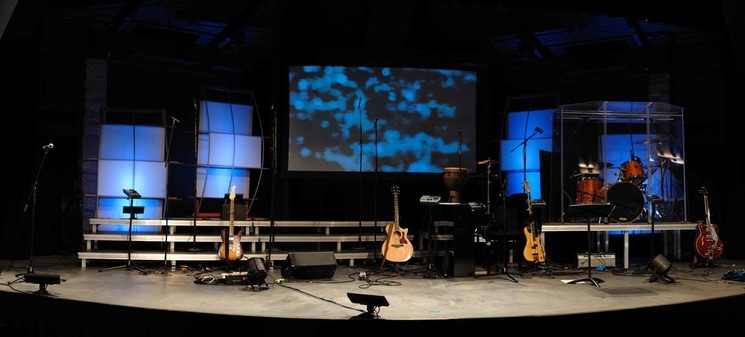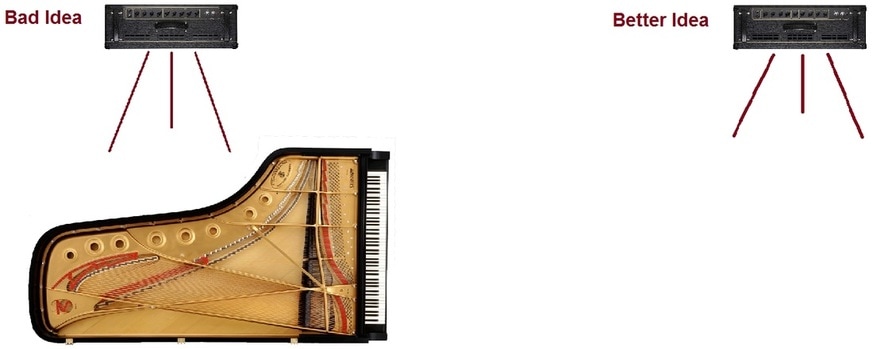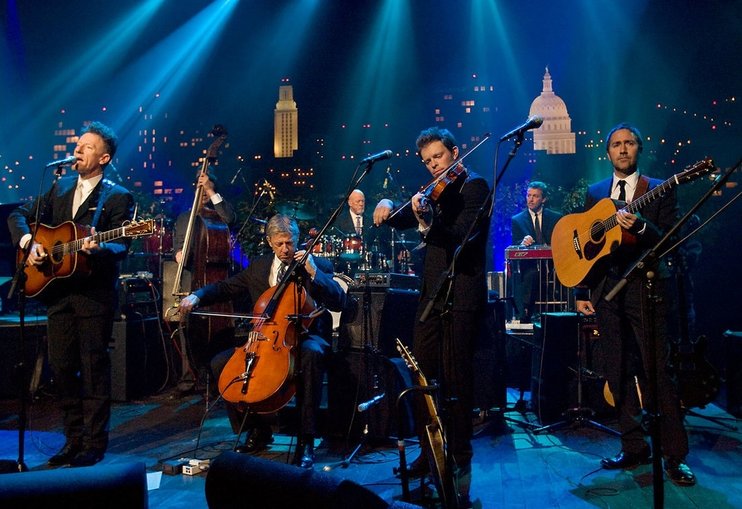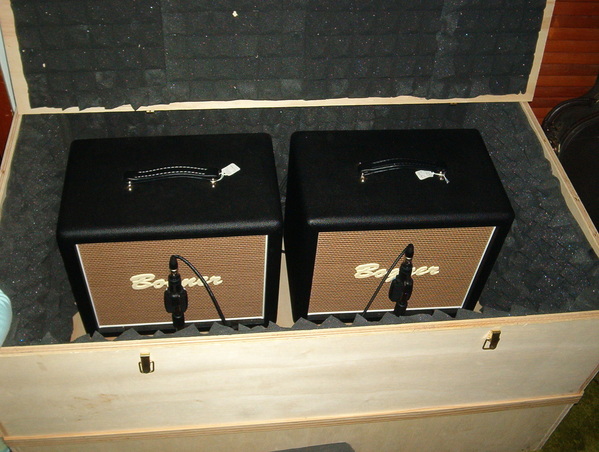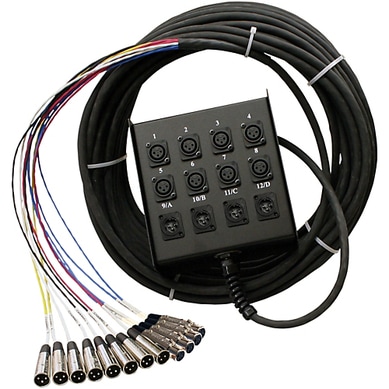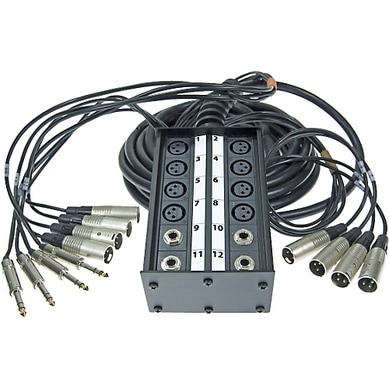Bleeding, Feedback, & Drum Booths
Being thoughtful and intentional about setting up a well planned stage plot can really solve many issues when it comes to things like feedback, sound quality, communication, etc. On this page, we are going to be covering the many facets of setting up a stage to where it really works for you and the band.
In a live situation, you are going to have bleed. This is the nature of the beast, and is actually one of the most glorious things about a live gig. This is not something to be frustrated or scared about, but to be celebrated. Now witht that said, lets discuss some ways to make your mix tighter and your job easier:
Partner Up
The first thing you should do before coming up with the best stage plot, is to meet with the worship leader and band members so that all of you can come to a consensus as to what setup best works for you. This will keep any surprises down to a minimum, and the band will appreciate you for it. For some people, the worst thing that could happen is for them to come in, and their area of the stage is totally different. Their instruments and amps have been moved, and now they are left scrambling right before the set of how to make their new area work. This is a no go, and should be avoided. Communication is the key.
Think It Through
Before you possibly move anyone, make sure that they will have everything they need in their new spot. The best way to ascertain this, is to go to their current location and look at their power, monitoring, audio I/O's, and similar. Make a running list of everyone's current needs, and then make sure their new spot can service them. If your stage features stage pockets, make sure they are configured correctly. In our buying guide section, we cover the best type of stage pockets you can purchase, but any decent brand will allow you to re-configure the plates for evolving needs.
Mic Placement & Instrument Placement
Be thoughtful in your approach to where you place microphones. Learn about the Null areas of each type of microphone to keep bleed from neighboring instruments or stage wedges under control. Not only will practicing correct mic placement yield a much more quality tone, but it will keep potential feedback issues at bay as well. Do you have a baby grand piano on stage? Placing it right in front a guitar amplifier or drum set may not be the best solution. You are bound to get a ton of bleed in your piano mics if you are not careful as to where you locate the piano on stage, and what direction you point the mics.
THINK ABOUT BEING INTENTIONAL
Check this out (what do you notice):
Drum overheads have minimum bleed because they are behind the band.
Guitar amps are in front of the drums and are (for the most part) mic'd with super cardioids.
Keys and the Leslie are behind the guitar amps and not directly in front of the drums.
Monitors shooting in the nulls of the vocal microphones.
Notice the sound absorption between the lead guitarist's amp and the keys area.
Here's another example:
FIND THE BALANCE BETWEEN A CLEAN MIX, AND NOT
UPSETTING WHOM YOU ARE SERVING
Don't be so hard headed that you are going to go for the ultimate stage plot while ignoring the needs of the musicians you areserving. Find the balance. If you are super polite and professional, most bands will compromise with what you want to achieve as well (within reason). Feel it out. Problem solve. Be bendable. If the musicians are not comfortable on stage, you can (and will) lose the vibe very quickly. That's a lose-lose situation.
Some other helpful ideas
Instrument / Amplifier Isolation
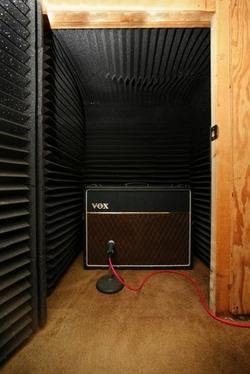
One way to deal with bleed and stage noise, is to isolate your guitar/bass amplifiers. Find an unused room in your facility as close to the stage as possible, and place your amplifier (if a combo amp) or speaker cabinet in it. You may have to acoustically treat the room to keep it from sounding too boxy, and/or to keep it from possibly interrupting what may be going on close by in an adjacent room. This can be done cheaply with old mattresses or moving blankets. I have also seen whole isolation booths made underneath a stage. You can also build iso-boxes if there's no such space available:
If you aren't too handy with woodworking, or if you don't have a carpenter friend, you can also purchase a professionally made iso-box from a few different manufacturers.
Note: Keep in mind that if you have a separate head and cab, it's the most advantageous to just put the cabinet in the isolated area, and run a long speaker cable to it from the amplifier head on stage. There will be no loss in tone that way. Now, if you have a combo amp, running a guitar signal cable a long distance, will induce a lot of capacitance - and by the time it gets to the amplifier, the guitarist's tone can sound very dull and dark. This is very common with long instrument cable runs (longer than 15ft). A way to combat this, is to use a boost or buffer at the end of your guitar effects chain before it is ran to the amplifier. There are a ton of great options out there. I know that Radial makes a guitar buffer unit as well as Palmer. Any boost will work too. The proper way to set up a boost as a buffer, is to compare the bypassed signal to the buffered signal. The buffered signal should just be a tad bit louder than the original un-buffered signal. This will guarantee that the effect of the boost/buffer is discernible. If done right, you should hear that the buffered signal will sound better than the un-buffered signal.
Drum Booths
|
Please don't buy a set of electronic drums. They sound terrible. The feel is off. And you'll never be able to recreate the responsiveness as what you have in a set of real drums. With that said, let's talk about drum isolation. Whatever booth or other isolation system you come up with, try and make the ceiling as high as you can get it. Drums need to breathe. The wave lengths of some of the larger drums, can extend to around 15 ft. This may not be a reasonable amount for the height of a drum booth in your particular situation, but I wanted to throw it out there as a general thought as something you can shoot for as far as being ideal. I've heard of guys building a drum booth quickly, and then they forgot to make sure the door was large enough so that a kick drum can actually fit through it! Take your time. Build it right. From there, you will need to acoustically treat most internal surfaces to keep the sound of your drums from being "boxy" in tone. Moving Blankets are a super cheap way to acoustically treat your iso booth, but if you have the money, you can also purchase acoustic panels (if this makes you feel better). Don't use carpet. It's only OK for absorbing high frequencies, and is totally ineffective in the absorption of lower frequencies. You have to have something thick to do that. Make sure there is a way for the drummer to see the entire band while sitting down. Work with your drummer(s) while building the booth so that you can make sure they have everything they will need to get the job done for every set. Also, keep in mind cabling. You can install a stage pocket if the drum booth is raised, or you can also put in a wall panel if you want a more trimmed look. Nothing wrong though with just drilling a hole in the back wall for an accessory drum snake.
|
|
In-Ear Monitoring
One of THE most effective ways in eliminating stage bleed and noise, is to use an In-Ear monitoring system. If you are going to go this route, don't buy the cheapest system possible. Do it right. Invest in the right material. My favorite is still Aviom. There are other fancier options out there, but I feel as if Aviom, for the performer, is a great solution. There are no menus to scroll through - making its' use super simple, and they last forever. You can get a great mix going within moments, and for the musician to tweak their mix on the fly, is very easy. Get the type of system that includes a signal splitter in the input module. This is super important, and will save you a ton of headache going forward. More about this is available in our Buyer's Guide section. It is also important to note, that investing in well made in-ears, is very important. Yes, there is a difference in the quality of sound you get from more expensive brands. Don't go cheap here. Buy it right the first time, and you won't have to keep buying over and over. Westone, 1964, and Shure, make great in-ears.
Direct Boxes and Other Tools
If you have a great in-ear monitoring system, you can ditch a bass amp and keyboard amplifiers as well. This is made possible by purchasing great direct boxes or preamps/amp simulators. Whirwind and Radial both come to mind here. The Tech 21 Bassdriver DI for bass guitar, makes an awesome direct box/preamplifier for bass guitars. For electric guitarists, there are digital options that sound pretty decent for live use. I for one think that digital has a long way to go before it will ever sound like a great tube amp cranked into tonal bliss, but brands like Kemper and AxeFX are getting closer (you better get ready to crank out some major change though because this technology isn't cheap). Some folks have settled for the cheaper Line 6 offerings, but if you have a good sounding tube amp, it would be worth the extra time to just isolate it into a different area. If you want an even cheaper option, Palmer makes a pretty decent cabinet simulator. A Tech 21 Sansamp is a classic product as well as their Character Series. For acoustic guitars, ditching the acoustic guitar amp, and going for a good sounding preamp, can also keep stage noise down. Fishman makes some of the better sounding acoustic pres I have heard.
